Best Dome Greenhouse: 3 Great Geodesic Kits To Try In 2024
So you spotted one of those geo dome greenhouse kits and now you’re interested in finding out more about them, right? Well the good news is that you’re in the right place.
In this article – We’ll cover exactly what you need to know about geodesic dome greenhouses and give you some examples of ones that you can buy to take your gardening game up a notch.
Here’s the lowdown:
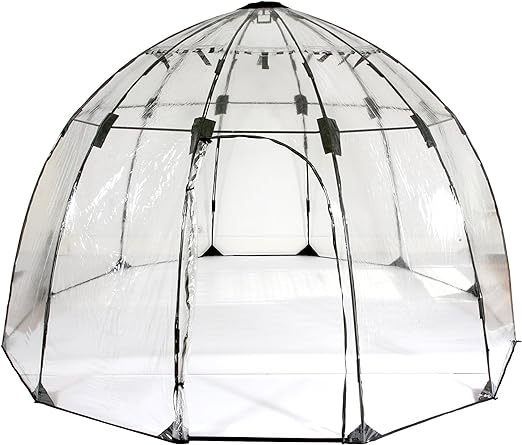
“In my opinion, the best dome greenhouse that will work for most gardeners is the Tierra Garden Sunbubble greenhouse. Not only is it a great price, but it is large and creates a really nice environment for your plants. If you’re looking for a basic geodesic greenhouse, then this is a great option.”
So if that’s all you wanted – then there you go. If you want more information about the pro’s and con’s of them then keep reading.
| Looking for the best polycarbonate greenhouses in 2024? The Best Polycarbonate Greenhouses To Buy In 2024 For People On A Budget |
Table Of Contents
My 3 Favorite Dome Greenhouse Kits
Tierra Garden Sunbubble (Best Everyday Dome Greenhouse)
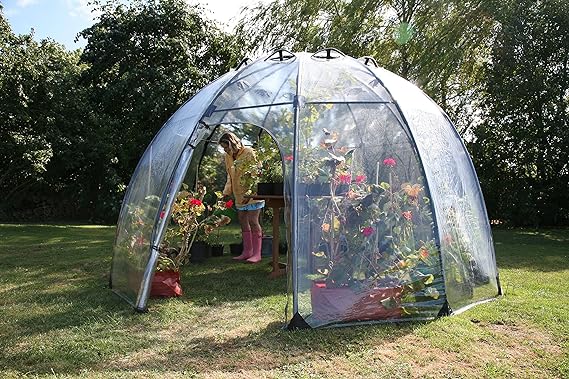
Where To Buy: Amazon
Specs & Features:
– Dimensions of 137.8″L x 137.8″W x 86.6″H
– Weight of 46 lbs
– Made of PVC with fiberglass rods for support.
– One-piece folding design makes it extremely easy to set up and use.
Overall Thoughts:
The reason why I rated this the best everyday geo dome greenhouse is because it is extremely lightweight, easy to use and practical for most people. The set up is easy and then it’s finished and giving you the benefits of a dome greenhouse. This is a high quality greenhouse that I was very happy using and that’s why I’m more than happy to recommend it to you.
| PROS | CONS |
| – Really easy to set-up and use. – Has adjustable vents that let you control the temperature and ventilation in the greenhouse. – There is plenty of room for different plants and you can work in it without stooping too much. – Looks really nice in the garden. | – It isn’t extremely sturdy, so keep it in a sheltered place. |
Other Details:
The Tierra Garden Sunbubble is a dome greenhouse that’s great for everyday use. It’s easy to set up, move, and store, making it super convenient for anyone who loves gardening but doesn’t want to deal with a lot of hassle. This greenhouse warms up fast and stays warm because of its shape, which catches sunlight all day long. It has vents you can adjust to keep the temperature just right and a zippered door to keep out pets. When you’re not using it, just fold it down and tuck it away in its storage bag. It’s made with sturdy materials like UV protected PVC and fiberglass rods, so it lasts a while too.
| Check Price ➡️ Amazon |
CZGBRO Dome Greenhouse Tent
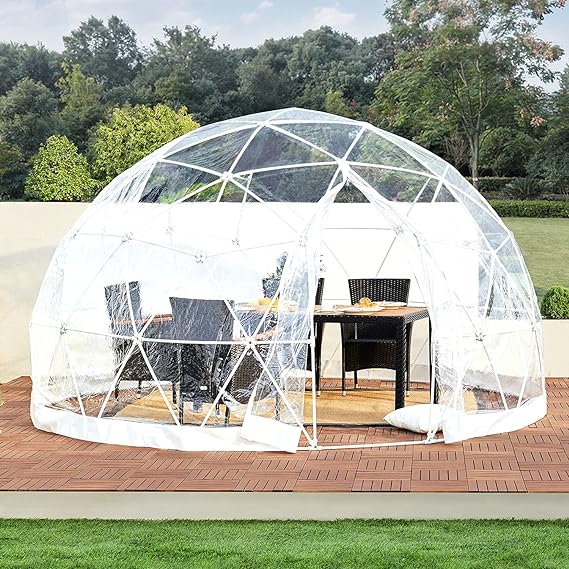
Where To Buy: Amazon
Specs & Features:
– Dimensions of 144″L x 144″W x 84″H
– Weight of 45 lbs
– Made of PVC and metal supports.
– Simple folding design makes it extremely easy to set up and use.
Overall Thoughts:
This is a bit more expensive, but you’re paying for quality here. This is a high quality greenhouse tent that has many uses besides just being a greenhouse. But it stays warm so your plants will love it, it’s easy to assemble and it works really well in all weather conditions. All around this is a really high quality dome greenhouse that you’ll be happy with.
| PROS | CONS |
| – Has multiple uses because you can use it for camping, gardening, hanging out and basically anything else outdoors. – High quality product that is really easy to assemble. – Stays surprisingly warm, making it nice for plant growth. – Sturdy and works well in most weather conditions. | – More expensive than other options. |
Other Details:
The CZGBRO Bubble Tent is basically a clear, dome-shaped greenhouse that you can set up anywhere. It’s made from strong plastic and PVC, which means it’s tough enough to handle different weather, like wind and snow. The whole thing is transparent, so lots of sunlight can get in, which is great for your plants. It’s pretty roomy inside — you can fit a bunch of plants and even some garden furniture. Setting it up is easy, and when you don’t need it, you can just take it down and store it away. This makes it super handy not just for your backyard, but you could even bring it along if you’re going camping and want a cosy spot to hang out.
| Check Price ➡️ Amazon |
Gojlex Dome Greenhouse Kit

Where To Buy: Amazon
Specs & Features:
– Dimensions of 12″L x 12″W x 7.2″H
– Weight of 63 lbs
– Made of PVC and plastic tube supports.
Overall Thoughts:
This is a heavier and more weather resistant option. It’s high quality, creates a great growth environment for your plants and it’s also nice and roomy so you have plenty of space. The cons of this geodesic dome greenhouse is that it is a bit harder to set up than the other instant greenhouses above and I also noticed that it can have wrinkles in the PVC plastic, which doesn’t hurt the performance, but it looks a bit worse. All around this is a solid option for someone that want’s something big and solid for their plants.
| PROS | CONS |
| – Heavier and more weather resistant than other dome greenhouse options. – High quality and durable, it will last for a long time. – Creates a really nice environment for your plants. – Large and roomy so you can have many plants in there along with chairs. | – A bit harder to set up than other dome greenhouse kits that we’ve spoken about. – Can get wrinkles in the PVC. |
Other Details:
The Greenhouse Garden Dome Igloo is a large, clear dome tent that’s great for growing plants or just hanging out outdoors. It’s made from sturdy plastic and thick PVC, which keeps it stable and weatherproof against wind, rain, and snow. You won’t have to worry about the elements messing with your plants or your chill time. This dome is not just tough, but also clear, so you can enjoy full views while staying protected from bad weather. It’s spacious enough inside for lots of plants and even some cosy garden furniture. You can grow anything from flowers to veggies in it, and it comes with a shade cover to prevent too much sunburn on your plants.
| Check Price ➡️ Amazon |
How To Build A DIY Dome Greenhouse
Building a DIY dome greenhouse can be a rewarding project that provides a great space for your plants to thrive year-round. Here’s a straightforward guide to help you get started:
Materials Needed:
- PVC Pipes: For the frame of the dome.
- Connectors: To connect the PVC pipes together (you may need various shapes like T-joints and elbow joints).
- Polycarbonate Sheets or Heavy-duty Plastic Sheeting: For the covering.
- Zip Ties or Metal Clips: To secure the covering to the frame.
- Door Hinge and Latch: For creating a door.
- Tools: Including a saw for cutting pipes, a drill, and possibly a staple gun.
If you want to take a few shortcuts then grab a pre-made geodesic frame and a plastic covering.
Here are my recommendations:
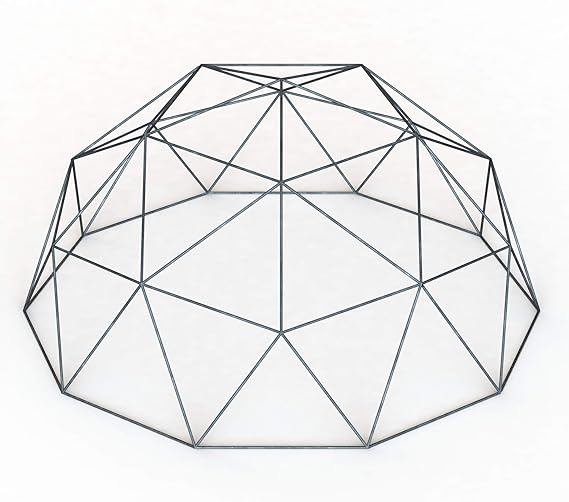
Where To Buy: Amazon
Specs & Features:
– 8.5ft high and 17ft in diameter
– Made of alloy steel
– Comes with detailed assembly instructions.
| Check Price ➡️ Amazon |
And for the covering, this is really nice plastic sheeting. (Important: Get more than you need because you don’t want to run out.

Where To Buy: Amazon
Specs & Features:
– 24′ x 25′ in dimensions
– Made of 6 mm greenhouse plastic film
– Allows up to 90% light transmittance and blocks 95% of UV rays.
| Check Price ➡️ Amazon |
Steps to Build a Dome Greenhouse:
- Design Your Dome: Determine the size of the dome and calculate how many pieces of PVC pipe you’ll need. There are dome calculators online that can help you figure out the exact specifications for a geodesic dome.
- Cut and Assemble the Frame: Cut the PVC pipes to the required lengths. Connect the pipes using the PVC connectors to form the dome structure. Make sure your dome has a solid base and evenly distributed panels.
- Cover the Dome: Once your frame is sturdy, cover it with polycarbonate sheets or heavy-duty plastic. Cut the material as needed to fit the dome’s panels. Secure the covering to the frame using zip ties or metal clips. Ensure that the plastic is taut and secure to minimize any flapping or tearing due to wind.
- Install the Door: Fit a door frame at one of the hexagonal or pentagonal openings using additional PVC pipes and connectors. Attach polycarbonate or plastic to the door frame and secure it with hinges and a latch.
- Seal All Gaps: Check for any gaps or openings where air might escape and seal these with extra plastic, silicone, or weather-stripping. This step is crucial for maintaining humidity (1) and warmth inside the dome.
- Ventilation: Consider installing manual or automatic vents in the top and sides of your dome to manage temperature and humidity.
- Final Touches: Add interior shelving or planting tables as needed. You can also install irrigation or misting systems to help with watering your plants.
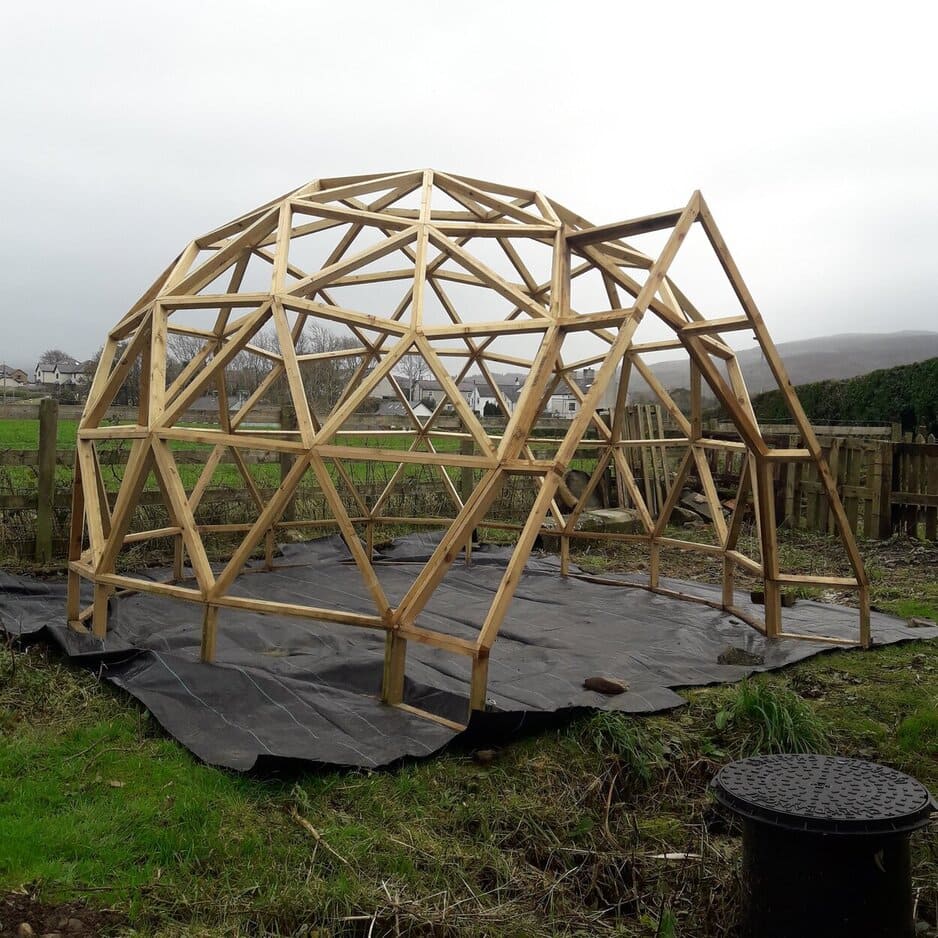
Tips:
- Location: Choose a spot that gets adequate sunlight and is protected from strong winds.
- Maintenance: Regularly check the structure for any damage or wear, especially after extreme weather conditions.
- Enhancements: Consider adding solar panels or LED grow lights for energy efficiency and extended plant growth cycles.
Building your own dome greenhouse can be a bit of an adventure, and it might take a bit of trial and error to get everything just right. But once it’s up, it can be a fantastic, functional space for gardening.
Pros And Cons Of Dome Greenhouses
Here are some of the pro’s and con’s of dome greenhouses.
What are the pros of dome greenhouses?
| Efficient Energy Use: | The shape of a dome greenhouse allows for the even distribution of heat and light, minimizing cold spots and shadows within the structure. This can lead to lower heating costs in colder climates and more efficient use of solar energy. |
| Strong and Durable: | The geodesic design of dome greenhouses provides natural strength and the ability to distribute structural stress evenly throughout the shape. This makes them particularly resistant to challenging weather conditions such as strong winds, heavy snowfall, and hail. |
| Optimal Air Circulation: | The curved surface of a dome encourages better air movement and natural ventilation. This helps maintain consistent temperatures and reduces the risk of plant diseases, which are often exacerbated by stagnant air. |
| Maximal Sun Exposure: | The dome’s shape ensures that sunlight is more uniformly distributed throughout the day. This is especially beneficial for plant growth as there are fewer direct sun or deep shade areas, which helps reduce the growth of algae and mold. |
| Space Efficiency: | The circular design eliminates wasted space common in traditional square or rectangular greenhouses. This makes it easier to set up plant arrangements and maximizes usable growing space. |
So those are all the exciting things that you can expect from owning a geodesic dome greenhouse. Here are the cons.

What are the cons of dome greenhouses?
| Complex Construction: | Although the end result is highly efficient, constructing a geodesic dome can be more complicated than building traditional rectangular greenhouses. The geometric design involves numerous triangular panels that need to be precisely sized and assembled, which can be challenging without the right tools and expertise. |
| Cost of Materials and Construction: | Due to their unique shape and the need for specific materials and connectors, dome greenhouses can initially be more expensive to build compared to standard greenhouses. Specialized components like custom-made hubs or specific types of coverings can add to the cost. |
| Temperature Control: | While domes distribute heat and light evenly, their volume can make it harder to control temperature and humidity, especially in larger domes. This might require more sophisticated ventilation and heating systems. |
| Limited Expansion: | Unlike traditional greenhouses that can be easily extended by adding more structure at the ends, expanding a dome greenhouse is not as straightforward and often requires building a new or entirely separate structure. |
| Condensation Management: | The shape of the dome can lead to water dripping from the center of the structure onto plants below, which could potentially cause disease or discomfort in humid conditions. Managing this requires careful placement of plants and possibly additional water diversion tactics. |
What is the difference between a greenhouse and a growing dome?
A greenhouse and a growing dome are both used for growing plants, but they’re built differently.
A greenhouse is usually rectangular and made with materials like glass or plastic to let in a lot of light. It’s a common choice for gardeners because it can be built in various sizes, and it’s pretty straightforward to expand if you need more space.
A growing dome, on the other hand, is shaped like a half-sphere or dome. This shape helps spread light and heat more evenly inside, which can be better for plant growth. Growing domes are also really strong and can handle harsh weather better than the typical flat-surfaced greenhouses. However, their curved shape can make it a bit harder to set up your plant shelves and requires a bit more effort in construction and layout planning.
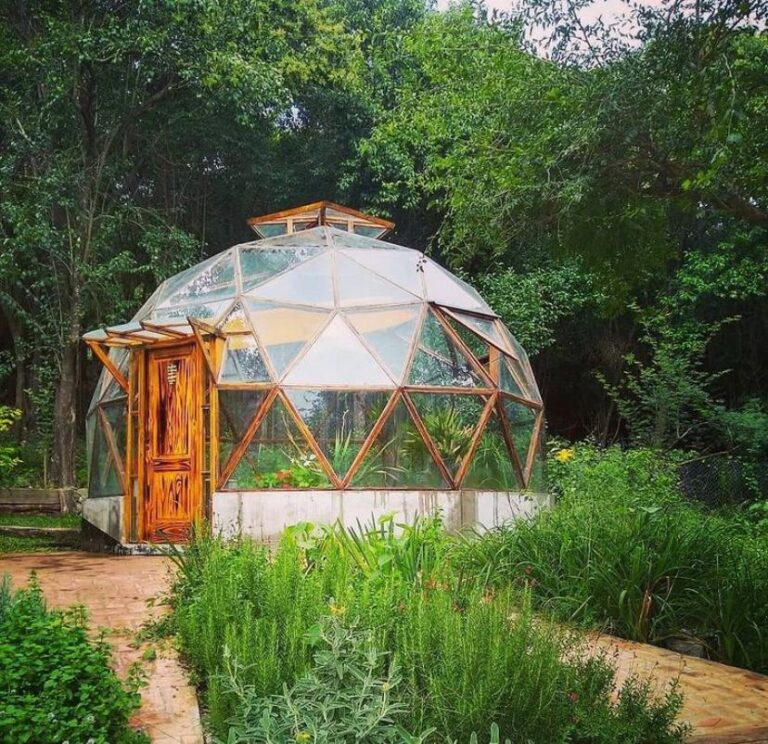
So, the main differences come down to their shape, how they handle weather, and how you arrange everything inside.
Conclusion:
Whether you’re just starting out in gardening or you’re a seasoned green thumb looking for a more robust solution, a dome greenhouse might just be what you need. With their unique geodesic design, these greenhouses offer efficient energy use, strong durability, and optimal conditions for plant growth, making them a smart investment for anyone serious about gardening. However, be prepared for a bit more complexity in setup and potentially higher initial costs compared to traditional greenhouses.
Ultimately, choosing between a dome greenhouse and a more conventional style boils down to your specific needs, budget, and how much time you’re willing to invest in setting up and maintaining your gardening space. With the right choice, you can transform your gardening experience and enjoy a lush, productive garden all year round.
| Here are some of my favorite greenhouse accessories: 14 Best Greenhouse Accessories That You Need In 2024 |
FAQs
Are dome greenhouses good?
Yes, dome greenhouses are quite beneficial, especially for efficient energy use, strength under adverse weather conditions, and maximizing space with their unique design. They provide even sunlight distribution and good air circulation, which are great for plant growth. However, they can be more complex and costly to set up compared to traditional greenhouses.
What is a greenhouse dome called?
A greenhouse dome is often called a geodesic dome greenhouse, referring to its specific structural style that uses a network of triangles to form a roughly spherical surface.
How much does a geodesic dome greenhouse cost?
The cost of a geodesic dome greenhouse can vary widely based on size, materials, and features, but generally, they start around $1,000 for basic kits and can go up to $25,000 or more for large, high-end models equipped with advanced features.
Do geodesic domes leak?
Like any structure, geodesic domes can leak if not properly assembled or maintained. However, their design doesn’t inherently make them more prone to leaks. Proper sealing, regular maintenance, and using quality materials are key to preventing water ingress.
Why are geodesic domes not popular?
Geodesic domes are not as popular as traditional greenhouses mainly due to their complexity in design and construction, higher initial costs, and the challenge of fitting standard greenhouse accessories like shelving inside a curved structure. They also require more specialized knowledge to design and build effectively, which can be a barrier for average gardeners.
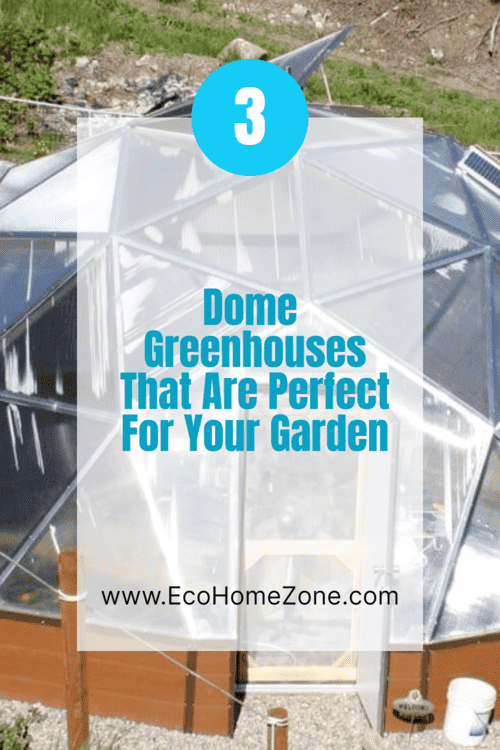
References:
1 – BBC Gardeners’ World Magazine, Using your greenhouse in autumn, Taken from: https://www.gardenersworld.com/plants/using-your-greenhouse-in-autumn/




